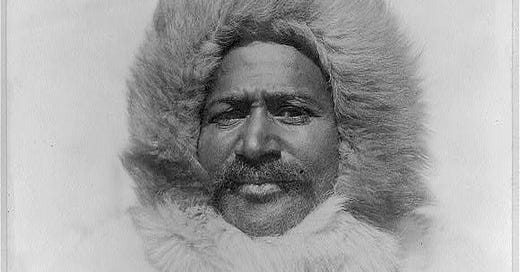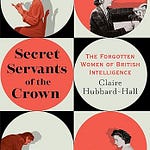Please note: we’ve kept all quotes in this snapshot in their original form.
Matthew Henson was one of the world's great explorers, achieving one of the most sought-after firsts amongst adventurers when he and a small group of men set foot on the North Pole on April 6, 1909. For Matthew, who was 42 years old at the time, it was the pinnacle of a life exploring that began at just 11 years old.
Matthew's early life mirrored the struggles of many black Southerners in the post-Civil War era. Born in 1866 to sharecropping parents, he grew up in an environment of financial hardship. His world was further upended when both his parents died by the time he was 11 years old. Orphaned, Matthew sought work to survive, eventually becoming a cabin boy on a merchant ship.
This job provided him with an income and opened a door to a world of adventure. But more importantly, under the mentorship of the ship's captain, he gained skills in navigation, seamanship, and geography. These skills would prove invaluable in his life as an explorer.
After several years at sea, Matthew settled in Washington, D.C.. He worked as a store clerk, where in 1887, he met Lieutenant Robert E. Peary, an ambitious U.S. Navy engineer preparing for a surveying expedition to Nicaragua. Immediately impressed by Matthew's maritime experience, mechanical skills, and sharp intellect, he hired him as a personal aide, beginning a partnership for decades.
The Nicaragua expedition proved Matthew's importance. Peary then invited him to join the next adventure, an Arctic expedition in 1891–1892. The Arctic was grueling and full of challenges and dangers, including sub-zero temperatures, ice floes, and scarce resources. Matthew would see two friends die on early expeditions. Yet, his desire to continue exploring remained unchanged.
While his expertise grew in these expeditions, Matthew developed a new skill centered around team camaraderie. Most of the group was made of Inuit men. Matthew took the time to learn the language and appreciate the men and their cultures. He would say about them,
"Naturally the impressions formed on my first visit to the Land of Ice and Snow were the most lasting, but in the coming years I was to learn more and more that such a life was no picnic, and to realize what primitive life meant. I was to live with a people who, the scientists stated, represented the earliest form of human life, living in what is known as the Stone Age, and I was to revert to that stage of life by leaps and bounds, and to emerge from it by the same sudden means. Many and many a time, for periods covering more than twelve months, I have been to all intents an Esquimo, with Esquimos for companions, speaking their language, dressing in the same kind of clothes, living in the same kind of dens, eating the same food, enjoying their pleasures, and frequently sharing their griefs. I have come to love these people. I know every man, woman, and child in their tribe. They are my friends and they regard me as theirs."
Matthew's connection with the Inuit team members and his skills made him an essential part of the successful trek to the North Pole. As one member of the expedition wrote,
"Matt was of more real value than the combined services of all of us. With years of experience, an expert dog driver, a master mechanic, physically strong, most popular with the Eskimos, talking the language like a native, clean, full of grit, he went to the Pole because Peary couldn't get along without him."
It was a moment of triumph when Matthew and the team reached the North Pole. Matthew later wrote in his autobiography,
"The Commander gave the word, 'We will plant the stars and stripes — at the North Pole' and it was done; on the peak of a huge paleocrystic floeberg the glorious banner was unfurled to the breeze, and as it snapped and crackled with the wind, I felt a savage joy and exultation."
Yet, upon returning to the United States, Matthew faced the harsh realities of racism. While Peary was celebrated as a hero, Matthew's contributions were largely overlooked outside of the black community. He took a job as a clerk at the U.S. Customs House in New York City, where he spent more than 30 years largely in obscurity. But he continued advocating for his rightful place in history.
Matthew's efforts eventually came to fruition. In 1937, the Explorers Club, a prestigious organization, inducted him as its first black American member. His contributions were further recognized seven years later when Congress awarded him the Peary Polar Expedition Medal. Then, decades after he died in 1955, Matthew's legacy received its most profound tribute: in 1988, his remains were reinterred with full honors in Arlington National Cemetery.
Sources:
Discovering Matthew Henson:
Henson, Matthew Alexander. A Negro Explorer at the North Pole. United States, Frederick A. Stokes, 1912.
"Matthew Alexander Henson." Arlington National Cemetery, https://www.arlingtoncemetery.mil/explore/notable-graves/explorers/matthew-henson
Matthew Alexander Henson, head-and-shoulders portrait, facing front, wearing his fur suit. Photograph. Retrieved from the Library of Congress, <www.loc.gov/item/00650163/>.
Robinson, Bradley. “Matthew A. Henson (1866-1955).” Arctic, vol. 36, no. 1, 1983, pp. 106–07. JSTOR, http://www.jstor.org/stable/40509478. Accessed 10 Dec. 2024.













Share this post